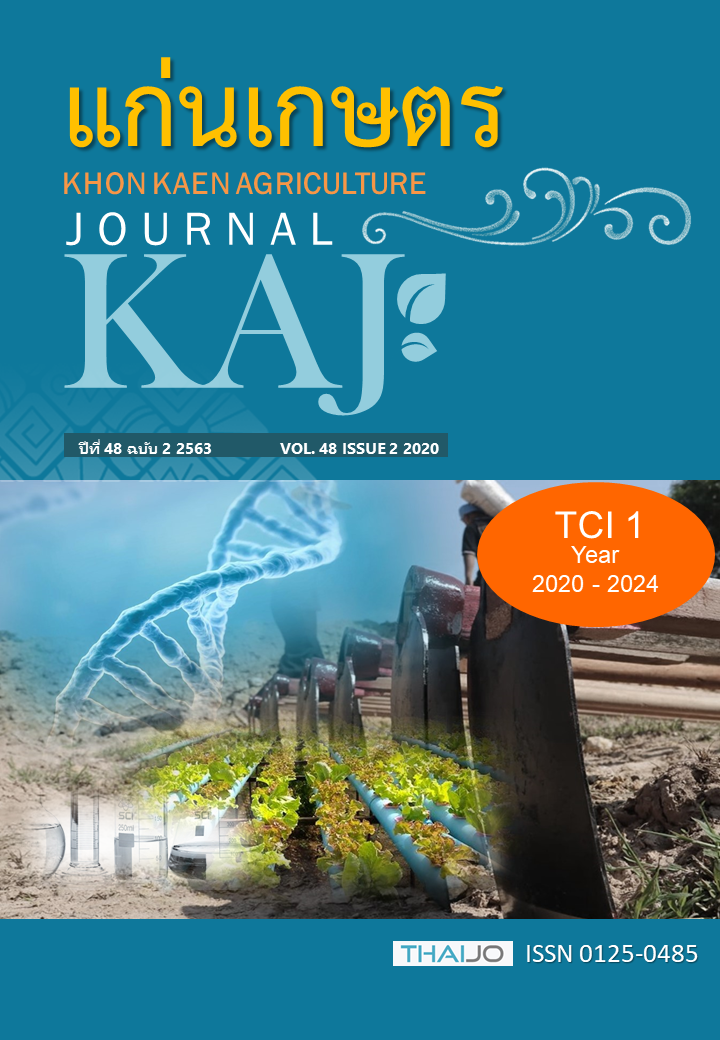การใช้กากถั่วเหลืองหมักด้วย Bacillus subtilis TJ-C9 ในอาหารสุกรอนุบาล
Main Article Content
บทคัดย่อ
การศึกษาการใช้กากถั่วเหลืองหมักด้วยเชื้อ B. subtilis TJ-C9 ในอาหารสุกรอนุบาล ได้ทำการศึกษาการเปลี่ยนแปลงรวมทั้งการใช้ประโยชน์ของสารอาหารหลังการหมัก ผลพบว่ากากถั่วเหลืองหมักมีโปรตีน ไขมัน และพลังงานรวมเพิ่มขึ้น 3.5, 13.59 และ 8.77% ตามลำดับ และปริมาณสารยับยั้งทริปซิน สารเบตา- คอนไกลซินิน สตาไชโอสและราฟฟิโนส ลดลง 81.8, 36.1, 80.0 และ 99.9% ตามลำดับ ส่งผลให้สุกรอนุบาลสามารถใช้ประโยชน์จากสารอาหารได้เพิ่มขึ้น โดยมีค่าการย่อยได้ของโปรตีนเพิ่มขึ้นจาก 73.86 เป็น 78.56% และค่าพลังงานที่ใช้ประโยชน์ได้เพิ่มขึ้นจาก 3,237 เป็น 3,562 กิโลแคลลอรี่/กก. เมื่อเทียบกับกากถั่วเหลืองก่อนการหมัก นอกจากนี้ทำการศึกษาการใช้กากถั่วเหลืองหมักทดแทนแหล่งโปรตีนต่างๆ ในอาหารสุกรอนุบาล โดยใช้สุกรลูกผสม อายุ 4 สัปดาห์ จำนวน 420 ตัว แบ่งเป็น 5 กลุ่มๆ ละ 6 ซ้ำๆ ละ 14 ตัว สุ่มสุกรให้ได้รับอาหารทดลองดังนี้ สูตร 1 อาหารควบคุมใช้ผลิตภัณฑ์ถั่วเหลือง (กากถั่วเหลืองกับถั่วเหลืองอบ) ปลาป่น และกากถั่วเหลืองหมักเอนไซม์ สูตร 2-5 อาหารที่ใช้กากถั่วเหลืองหมักทดแทนโปรตีนจากผลิตภัณฑ์ถั่วเหลือง ปลาป่นที่ระดับ 50% และ 100 % และกากถั่วเหลืองหมักเอนไซม์ ตามลำดับ พบว่าสมรรถภาพการเจริญเติบโตของสุกรในช่วงอายุ 5-9 สัปดาห์ มีความแตกต่างกันอย่างไม่มีนัยสำคัญทางสถิติในระหว่างกลุ่มทดลอง แต่การใช้กากถั่วเหลืองหมักทดแทนโปรตีนจากผลิตภัณฑ์ถั่วเหลืองมีผลทำให้ค่าอัตราการเปลี่ยนอาหารเป็นน้ำหนักตัวของสุกรดีขึ้น 5.3% โดยสรุปการหมักกากถั่วเหลืองด้วยเชื้อ B. subtilis TJ-C9 ช่วยปรับปรุงคุณภาพของกากถั่วเหลืองและสามารถใช้ทดแทนแหล่งโปรตีนคุณภาพดีในอาหารสุกรอนุบาลได้
Article Details
เอกสารอ้างอิง
สีทอง พิพัคะวงศ์. 2540. การศึกษาพยาธิวิทยา อาการทางคลินิกและผลของอิมมูโนโกลบูลินในการป้องกันโรคท้องร่วงโดยการทดลองให้ติดเชื้อ อี. โคไล ในลูกสุกรแรกเกิดซึ่งให้ขาดน้ำนมเหลือง. วิทยานิพนธ์ปริญญาวิทยาศาสตรมหาบัณฑิต มหาวิทยาลัยเกษตรศาสตร์, กรุงเทพฯ.
อังคณา หาญบรรจง และ ดวงสมร สินเจิมสิริ. 2532. การวิเคราะห์และการประเมินคุณภาพอาหารสัตว์. ภาควิชาสัตวบาล คณะเกษตร มหาวิทยาลัยเกษตรศาสตร์, กรุงเทพฯ.
Adeola, O. 2001. Digestion and balance techniques in pigs. P. 903-916. In: A.J. Lewis and L.L. Southern. Swine Nutrition. 2nd Edition. CRC Press, Florida.
AOAC. 1990. Official Methods of Analysis. 15th Edition. Association of Official Analytical Chemists, Inc., Washington, D.C.
AOCS. 1998. Official Methods and Recommended Practices of the AOCS. 5th Edition. American Oil Chemists’ Society, Champaign, IL.
Baker, D.H. 2000. Nutritional constraints to the use of soy products by animals. P.1–12. In: J.K. Drackley. Soy in Animal Nutrition. Federation of Animal Science Societies, Illinois.
Barbosa, T.M., C.R. Serra, R.M.La Ragione, M.J. Woodward, and A.O. Henriques. 2005. Screening for Bacillus isolates in the broiler gastrointestinal tract. Appl. Environ. Microbiol.71: 968–978.
Bradley, M., K. Lindsay, and J.A. Lindsay. 1991. Purification and characterization of a thermostable α-Glucosidase from a Bacillus subtilis high-temperature growth transformant. Curr. Microbiol. 22: 273-278.
Cervantes-pahm, S.K., and H.H. Stein. 2010. Ileal digestibility of amino acid in conventional, fermented, and enzyme-treated soybean meal and in soy isolate, fish meal, and casein fed to weanling pigs. J. Anim. Sci. 88: 2674–2683.
Chen, C.C., Y.C. Shih, P.W.S. Chiou, and B. Yu. 2010. Evaluation nutritional quality of single stage- and two stage-fermented soybean meal. Asian-Australas. J. Anim.Sci. 23: 598–606.
Feng, J., X. Liu, Z.R. Xu, Y.R. Lu, and Y.Y. Liu. 2007a. Effect of fermented soybean meal on intestinal morphology and digestive enzyme activity in weaned piglets. Dig. Dis. Sci. 52: 1845–1850.
Feng, J., X. Liu, Z.R. Xu, Y.R. Lu, and Y.Y. Liu. 2007b. The effect of Aspergillus oryzae fermented soybean meal on growth performance, digestibility of dietary components and activities of intestinal enzyme in weaned piglets. Anim. Feed Sci. Tech. 134: 295–303.
Hong, K.J., C.H. Lee, and S.W. Kim. 2004. Aspergillus oryzae GB-107 fermentation improves nutritional quality of food soybeans and feed soybean meals. J. Med. Food. 7: 430–435.
Hosoi, T., A. Ametani, K. Kiuchi, and S. Kaminogawa. 2000. Improved growth and viability of lactobacilli in the presence of Bacillus subtilis (natto), catalase, or subtilisin. Can. J. Microbiol. 46: 892-897.
Hu,Y., Y. Dun, S. Li, S. Zhao, N. Peng, and Y. Liang. 2014. Effects of Bacillus subtilis KN-42 on growth performance, diarrhea and faecal bacterial flora of weaned piglets. Asian-Australas. J. Anim.Sci. 27: 1131-1140.
Jones, C.K., J.M. Derouchey, J.L. Nelssen, M.D. Tokach, S.S. Dritz, and R.D. Goodband. 2010. Effect of fermented soybean meal and specialty animal protein sources on nursery pig performance. J. Anim. Sci. 88: 1725–1732.
Kook, M., S. Cho, Y. Hong, and H. Park. 2014. Bacillus subtilis fermentation for enhancement of feed nutritive value of soybean meal. J. Appl. Biol. Chem. 57: 183–188.
Kong, C. and O. Adeola. 2014. Evaluation of amino acid and energy utilization in feedstuff for swine and poultry diets. Asian-Australas. J. Anim. Sci. 27: 917-925.
Kwon, D.Y., W. James, H.J. Kim, and S. Park. 2010. Anti-diabetic effects of fermented soybean products on type 2 diabetes. Nutr. Res. 30: 1–13.
Lalles, J.P. 1993. Soy products as protein sources for pre-ruminant and young pigs. P. 106-125. In: J.K. Drackley. Soy in Animal Nutrition. Federation of Animal Science Societies, Illinois.
NRC. 2012. Nutrient Requirement of Swine. 11th Edition. National Academy Press, Washington, DC.
Pluske, J.R., D.J. Hampson, and I.H. Williams. 1997. Factors influencing the structure and function of the small intestine in the weaned pig: a review. Livest.Sci. 51: 215-236.
Qin, G., E.R. Elst, M.W. Bosch, and A.F.B. van der Poel. 1996. Thermal processing of whole soybeans: studies on the inactivation of anti-nutritional factors and effects on ileal digestibility in piglets. Anim. Feed Sci.Technol. 57: 313–324.
Rocklin, R.D., A.P. Clark, and M. Weitzhandler. 1998. Improved long-term reproducibility for pulsed amperometric detection of carbohydrates via a new quadruple-potential waveform. Anal. Chem. 70: 1496-1501.
Rojas, O.J. and H.H. Stein. 2013. Concentration of digestible, metabolizable, and net energy and digestibility of energy and nutrients in fermented soybean meal, conventional soybean meal, and fish meal fed to weanling pigs. J. Anim. Sci. 91: 4397–4405.
Rojas, O.J. and H.H. Stein. 2015. Effect of replacing fish, chicken, or poultry by- product meal with fermented soybean meal in diets fed to weanling pigs. Rev. Colomb. Cienc. Pecu. 28: 22–41.
Van Biert, M. and M. Hessing. 1993. ELISA procedure for the determination of soya glycin and conglycinin.TNO Nutrition and Food Research, Zeist, Netherlands.
Van Dil, J.M. and M. Hecker. 2013. Bacillus subtilis: from soil bacterium to super-secreting cell factory. Microb. Cell. Fact. 12: 1–6.
Whittemore, C.T. 1993. The Science and Practice of Pig Production. Longman Scientific and Technical, Longman Group, UK.
Yang, Y.X., Y.G. Kim, J.D. Lohakare, J.H. Yun, J.K. Lee, M.S. Kwon, J.I. Park, Y.K. Choi, and B.J. Chae. 2007. Comparative efficacy of different soy protein sources on growth performance, nutrient digestibility and intestinal morphology in weaned pigs. Asian-Australas. J. Anim. Sci. 20: 775-783.
Zhang, H. Y., J. Q. Yi, X.S. Piao, P.F. Li, Z.K. Zeng, D. Wang, L. Liu, G.Q. Wang, and X. Han. 2013. The metabolizable energy value, standardized ileal digestibility of amino acids in soybean meal, soy protein concentrate and fermented soybean meal, and the application of these products in early-weaned piglets. Asian- Australas. J. Anim. Sci. 26: 691-699.


